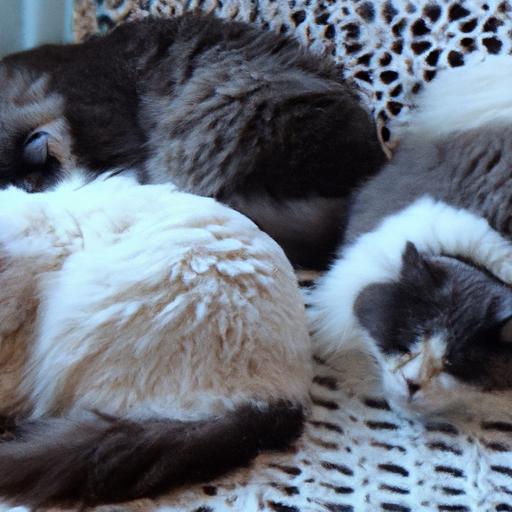
Introducing New Cats to Each Other: A Step-by-Step Guide
Learn how to introduce new cats to each other smoothly with our step-by-step guide. Create a harmonious environment for your feline companions.
Introduction
Are you considering adding a new furry friend to your family? Introducing new cats to each other can be an exciting but delicate process. Creating a harmonious environment where your cats can coexist peacefully is essential for their well-being and your own sanity. In this article, we will provide you with a comprehensive guide on how to introduce new cats to each other successfully. Whether you are introducing adult cats or integrating a new kitten into your household, we’ve got you covered!

Understanding Cat Behavior
Before diving into the introduction process, it’s crucial to understand the intricate world of feline behavior. Cats are known for their independent and territorial nature, making the introduction process a sensitive task. Several factors can influence their interactions, including age, gender, territory, and socialization history.
Instinctual Behaviors of Cats
Cats are instinctively inclined to establish their territory and defend it against potential threats. When introducing new cats, it’s essential to respect their natural instincts. By gradually introducing the new feline, you can help reduce the stress and potential conflicts that may arise during the process.
Factors Affecting Cat Interactions
-
Age and Gender: The age and gender of your cats can play a significant role in how they interact with each other. Introducing kittens to adult cats requires careful supervision and gradual introductions to ensure the older cat doesn’t feel overwhelmed or threatened. Similarly, introducing adult cats of opposite genders may require more patience and time for them to establish a bond.
-
Territory and Space: Cats are territorial creatures, and intruding on their established space can cause anxiety and aggression. When introducing new cats, it’s crucial to provide separate spaces for each cat initially. This allows them to become familiar with their own territory and gradually adjust to the presence of the other cat.
-
Socialization History: Cats with limited socialization experiences may find it more challenging to adapt to a new feline companion. It’s important to consider each cat’s socialization history and provide them with positive experiences and interactions to build trust and reduce any potential anxiety.

Step-by-Step Guide to Introducing New Cats
Now that we have a better understanding of cat behavior and the factors influencing their interactions, let’s explore the step-by-step process of introducing new cats to each other.
Pre-Introduction Preparations
-
Creating Separate Spaces: Start by setting up separate spaces for each cat, complete with food, water, litter boxes, and comfortable resting areas. This allows each cat to establish their own territory and feel secure.
-
Familiarizing Cats with Each Other’s Scent: Cats rely heavily on their sense of smell to identify others. Swap bedding or use a cloth to rub the scent of one cat onto the other, gradually introducing their scents to each other. This helps familiarize them with the presence of the other cat without direct interaction.
Initial Introduction Techniques
-
Using a Gradual Introduction Method: Begin by allowing the cats to see each other through a barrier, such as a baby gate or cracked door. This visual introduction helps them become familiar with the sight of the other cat without direct contact.
-
Controlled Visual Introduction through a Barrier: Gradually increase the exposure time by feeding both cats on either side of the barrier. This positive association with each other’s presence helps create a sense of camaraderie between the cats.
Progressing the Introduction Process
-
Supervised Face-to-Face Interactions: Once both cats are comfortable with the barrier, it’s time to move to supervised face-to-face interactions. Start with short sessions in a neutral territory, such as a room both cats are unfamiliar with. Monitor their behavior closely and be prepared to intervene if any signs of aggression or stress arise.
-
Encouraging Positive Experiences through Play and Treats: Engage both cats in interactive play sessions using toys or laser pointers. This shared activity can help build positive associations and gradually foster a bond between them. Reward good behavior with treats to reinforce positive interactions.
FAQ about Introducing New Cats to Each Other
Can I introduce adult cats to kittens?
Yes, it is possible to introduce adult cats to kittens. However, it requires careful supervision and gradual introductions to ensure the safety and well-being of both cats. The adult cat may need time to adjust to the energy and playfulness of the kitten, so it’s important to provide them with separate spaces when needed.
How long does the introduction process usually take?
The introduction process can vary greatly depending on the cats involved. Some cats may establish a bond relatively quickly, while others may take several weeks or even months. Patience is key during this process, and it’s important to go at the pace that is comfortable for both cats.
What should I do if the cats show aggression towards each other?
If the cats display aggression towards each other, it’s essential to intervene and separate them immediately. Allow them time to calm down before trying another introduction. If the aggression continues, consult with a veterinarian or a professional animal behaviorist for guidance on how to address the issue.
Can I introduce cats from different breeds?
Yes, cats from different breeds can be introduced to each other. Breed differences should not be a significant concern during the introduction process. It’s more important to focus on their individual personalities, socialization history, and the gradual introduction techniques mentioned earlier.
Conclusion
Introducing new cats to each other can be a rewarding experience when approached with care and patience. By understanding cat behavior, creating separate spaces, and following a step-by-step introduction process, you can help your cats develop a harmonious relationship. Remember, each cat is unique, and the introduction process may take time. With consistency and positive reinforcement, you can create a loving and peaceful environment for all your feline companions.
For more information on cat care and behavior, check out these helpful resources:























